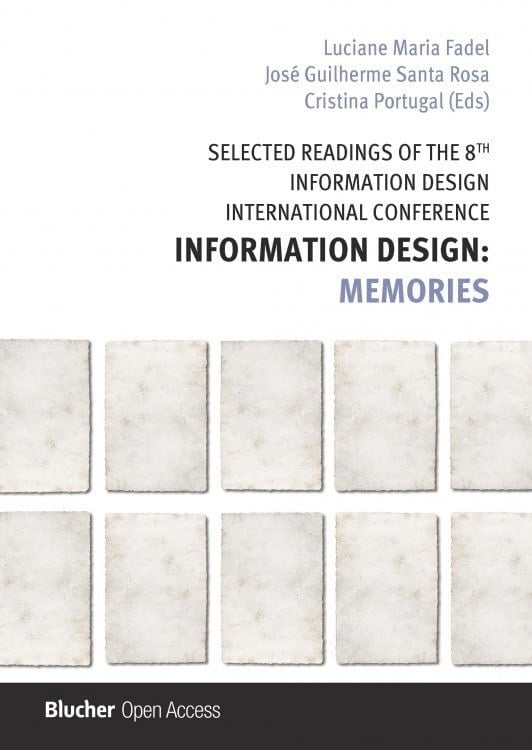
ISBN: 9788580393712
Páginas: 382
Ano da edição: 2019
DOI: 10.5151/9788580393712
Total de downloads: 4.061
Selected Readings of the 8th Information Design International Conference - Information Design: Memories: Memories
Baixar PDF Completo
Pré-textuais
-
Open Access
PDF - p.1-14
Part 01
-
Open Access
PDF - p.15-26
-
Open Access
02 - Infographics and narrative: exploring concepts
PDF - p.27-50
-
Open Access
PDF - p.51-70
-
Open Access
PDF - p.71-92
Part 02
-
Open Access
05 - Visualizing data on graphic memory research
PDF - p.93-114
-
Open Access
06 - Digital datasheet for archives of images
PDF - p.115-136
-
Open Access
07 - Information on the road: towards a methodology for the study of truck art
PDF - p.137-160
Part 03
-
Open Access
08 - From Pará to Brazil, João Francisco Madureira: a pioneer in Brazilian type design
PDF - p.161-178
-
Open Access
PDF - p.179-200
-
Open Access
10 - A picture of time and knowledge in the almanacs from Amazonas (1870 to 1927)
PDF - p.201-220
Part 04
-
Open Access
11 - Methodological procedures for the interpretation of images present in tactile illustrated books
PDF - p.221-236
-
Open Access
PDF - p.237-252
-
Open Access
13 - Memory aids, information artifacts and aging: medication-taking strategies
PDF - p.253-280
Part 05
-
Open Access
14 - The trajectory of design/education at UFPE and the actions of RIDE
PDF - p.281-310
-
Open Access
PDF - p.311-338
-
Open Access
PDF - p.339-360
-
Open Access
17 - Drawing or Design? Contribution to the definition of designology
PDF - p.361-382
This book starts with Spinillos’s provocation: to compare medicines and industrialized food/beverage products. This provocation is based on the fact that poor legibility and
readability of informative texts, the use of technical jargons and small typographic font size are problems common to medicines inserts, nutrition facts, and lists of ingredients of
food/beverage products. Spinillo argues that critical information about food composition should be presented as clearly as possible to consumers. This information is designed to support a narrative. The importance of narratives in design has been central to many studies (Bizzocchi, 2014; Forlizzi and Ford; Grimaldi, Fokkinga, and Ocnarescu, 2013). Although its importance is well accepted, a more precise concept and typology of narratives in design are still being constructed. Another design artifact that is based on narratives is the infographic that uses pictures and text to express temporality creatively. Vieira, Cunha, and Rolim explored the relationship between narratives and infographics to bring a broad view of what are the main issues
being discussed in Brazil.
- And, José Guilherme Santa Rosa
- Azerêdo, Júlia Sousa
- Barbosa, N.C.
- Cadena, R. A.
- Campello, Silvio B.
- Coutinho, S. G.
- Coutinho, Solange
- Cunha, Paulo
- Domiciano, Cassia Leticia Carrara
- Fadel, Luciane Maria
- Farias, Priscila Lena
- Fonseca, Letícia Pedruzzi
- Gonçalves, Berenice Santos
- Hennes, Mariana
- Jacob, Regina Tangerino de Souza
- Lessa, Washington Dias
- Lima, Edna Cunha
- Lima, Guilherme Cunha
- Lopes, M.T.
- Machado, Tacianne Kriscia
- Martins, Fernanda de O.
- Mazzilli, Clice de Toledo Sanjar
- Medeiros, Ligia Maria Sampaio de
- Medina, Camila
- Moraes, Laíse Miolo de
- Moreira, Luiza Avelar
- Mota, Marina L. P.
- Pereira, Rômulo do Nascimento
- Portugal, Cristina
- Providência, Francisco
- Queiroga, Jonas Silva
- Rolim, Eva
- Romani, Elizabeth
- Silva, Claudio Henrique da
- Souza, Angélica Porto C. de
- Spinillo, Carla Galvão
- Velloso, Bruno Panerai
- Vieira, Rosângela
